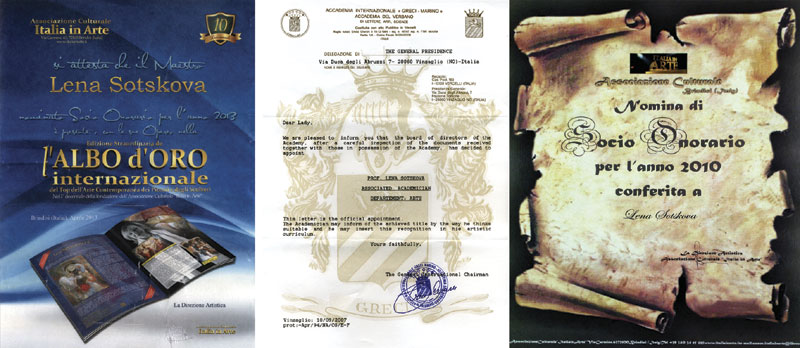Official website of Lena Sotskova

Biography
|
Lena Sotskova was born in Traveling extensively with her parents, and later by herself,
Sotskova visited She started painting at the age of four which prompted her parents to seek formal education for her in art school and through private lessons from extremely talented and highly acclaimed artists. Studying music and art simultaneously until the age of seventeen, Sotskova gravitated to the canvas. Her renderings celebrated her love for the fine arts through the continuous exploration of musicians and dancers as subjects. At a young age After her many years of formal education in art and a wealth of
cultural experiences, she relocated to New York City where the
vibrancy and excitement of the place coursed new life, impulse, and
enthusiasm into the veins of her art. In
|
 |
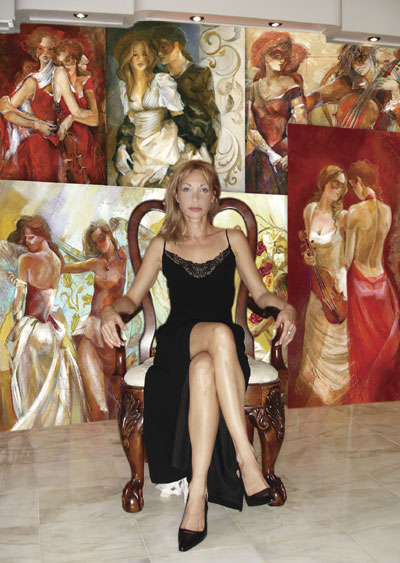 Lena
Sotskova at herMiami studio. Lena
Sotskova at herMiami studio.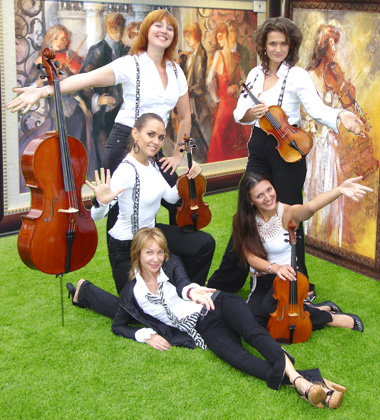 Lena Sotskova with Inspiration Strings quartet in London. |
Not only did her creativity evolve and take flight in Art publishers inundated Sotskova with offers to contract her and print editions of her works. However, her knowledge of the sometimes treacherous art world coupled with her finely tuned intuition averted her taking a step that had the potential to extinguish her creativity. Lena Sotskova spends from 1 to 3 month on each
oil on canvas painting, infusing her whole
heart and soul into each work of art. Sotskova could not stomach compromising her creative freedom and inspirations to be ordered to paint using the hot colors of the season or to produce paintings to match some lady’s drapes. It was essential for her to maintain full license over her ideas, individuality, and gifts without having to be told how and what to paint. Refusing to sacrifice quality in her work in exchange for the quantity of mass production, the artist opted out of publishing. Sotskova’s intuition proved to be keen as evidenced in the exponential growth of public interest in her art. Collectors began buying her paintings faster than she could create them, and six years after opening Hermitage, she sold the gallery to focus her efforts on creating and selling her own works. |
|
Commencing yet another chapter of life, Lena Sotskova moved to Formally educated at
One of today’s most acclaimed
painters with many international awards and titles, Lena
Sotskova presently resides in Lena Sotskova does not repeat herself in her paintings, evolving to the next, more superior level in every new art piece. |
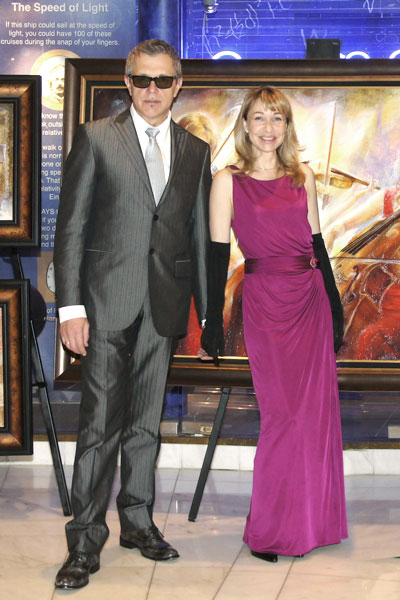 Lena Sotskova reception. |
|
Q: While growing up as a child, describe how your exposure to classical music and musicians shaped you as an artist? A: We are surrounded by music everywhere. From kid with headphones to classical music connoisseur we exposed to music throughout our lives. For me it were piano evenings at my parents home, frequent visits to “Bolshoy” theatre in Moscow, opera, ballet… I was lucky to be introduced at my early ages to music of Tchaikovsky, Rossini, Mozart, Beethoven... to have a fortune to visit European capitals and to be exposed to vast riches of centuries of music and art. I don’t want to bore you with list of names and titles of composers, whose music I admire, played myself and some of them I met personally. I studied music and art simultaneously from age 4 to 17, and then dropped the music and dedicated myself entirely to the painting and studied 6 more years in Art University. I was blessed with gifted and caring teachers, and also with my ability to feel the music and understand it on a deeper level but I gravitated to canvas. That exposure to classical music shaped me as an artist and most importantly as a person, as a human being. I strongly believe that good classical music, like a good painting makes us better; and contrary: commercial, mass-produced music and art creates bad taste and have negative effect on people’s lives; some of it can even trigger violence, depression, and make people physically sick. Q: How does music influence your work? A: Every painting for me has a melody. And vice versa, when I hear a melody I imagine how it will look on canvas. That’s how many of my paintings were born. When a melody creates an image in my mind and I transfer it to canvas, that melody stays with me during all the process, separating me from the reality and giving me a “shell” when I paint. I am a kind of strange person: when I paint and music plays in my head I forget about everything else. Don’t ask me questions at that time: I don’t know when I eat last time; it is now summer or winter; what country I’m in now. I want to tell you about another influence. William Shakespeare said: “All the world's a stage, And all the men and women merely players.”. This philosophy has a tremendous influence on my art. In my paintings I try to tear off peoples masks and reveal their inner personalities. And I believe that music helps here, because when real talented musicians play, they forget about public, they do it with all their hearts and at that moment the masks and makeup of performers disappear and power of their talent brings their souls to the surface, and truth revealed. Q: Describe how/why the art world appeals to music lovers. A: I can not speak for all art world. I don’t even know what Art World is. I know personally many talented artists, publishers, gallery owners, auctioneers, but it is not like we are union members and at our convention we make plans for directions of development of visual arts. When I create painting with musical theme I not intended to appeal to music lovers; to tell you the truth at the moment of creation I don’t think of anything, I just let myself go with the flow and I let the inspiration guide me. And I do not plan my paintings. Painting is just the way to express my feelings. With my paintings I do not try to please anyone, including music lovers, it is just happens that they love it. |
 |
 |
Q: Have you noticed a crossover of people who were never previously interested in art, drawn into the art world because of your work? A: It happens a lot. I remember my show on cruise ship “Azamara Quest”, we where sailing thru Panama Canal and there was young couple Brittany and Todd from Utah. They just were having fun and never even thought of becoming art collectors. They were passing by my paintings on the ship and got interested, by the end of cruise they bought several of my paintings. I liked them and felt like painting, I made drawing of them on that ships stationary using pen. They cried, they say I caught their personalities. After returning home I saw their blog on internet, where they displayed that drawing and other paintings with emotional words. That’s how I know they liked it. Similar story happened during my show in Wentworth gallery in Chicago. Couple was passing by, saw my paintings on display, they came in and you know the rest. At my shows I speak with people about art of Michelangelo, Rembrandt, I tell them stories of Leonardo da Vinci, Botticelli. I want to educate them a little while I can and to draw them into The Art, to convert some of them from shoppers of colored pictures that match their drapes to deeper level of understanding of the meaning of all this. What really makes me happy is not sales numbers of my paintings (please don’t get me wrong); and not compliments from gallery owners during price negotiation process. I’ll tell you what it is. I am happy seeing my painting as a screen saver in a college student’s phone and laptop, as an cover for a poetry book, and classical concert poster. Also all over internet they discuss my paintings in forums, display them in some kind of chat-blog-personal web pages. It is adorable: they cut parts of my paintings they like, put them on their own background with romantic poetry and music playing. And they do it in different languages: from Italian to Korean. That’s what makes me happy. Also German young girl who put in her questionnaire: favorite artist – Lena Sotskova. That is the people I work for, and if my paintings drawn them into The Art, my mission is complete. My favorite comment that one little Russian girl gave to my painting on one of websites: “I love this painting, I don’t know why”. After I’ve said that I have to explain that we don’t sell my art (neither originals, nor limited editions) on Ebay, or any online auctions or shops. My husband Sergei who is my one and only publisher is very careful with distribution and selectively intersperse it into the art market to preserve exclusivity of each piece. We don’t mind kids download my images for noncommercial use to enhance their web pages (although no permission was given), but those who engaged in illegal copying of my work we take very seriously. Unfortunately people make knockoffs of my art, fake and unauthorized copies. Q: How would you describe your unique style? How did you arrive at that style (or how did you evolve to develop that style?) A: I would say that styles affiliation is very approximate or conditional. My style combines elements of Florentine school of Renaissance, Academic art and Romanticism of early 1800s. During my life in arts I tried myriad styles and techniques before arriving to this one. It is combination of my love for experimenting with textures and working with sketches. As a result, light image appears on canvas, like if it was created in a single breath with strong “realism” elements that gradually dissolve into a texture. I don’t want to go too technical here... The thing is, I am lucky to have a really good art education that includes deep studies of world art styles and techniques, work around the clock with masters of painting, years of restoration work, studies of every muscle of human body in morgue (they cut actual corpses before my eyes); that’s why I don’t need models for my paintings. So, I guess, my stile is a result of all that. |
|
Q: Have you noticed an increase in the popularity of music art? If so, why do you think that is? A: Let’s imagine for a moment that I answer “Yes” to this question. After reading that some publishers and gallery owners will demand music art from their artists, and I am not sure such “art movement” would be successful. So, to be in a safe side I answer: good, professional musical art is popular at all times. The subject of music was romanticized in visual arts through the centuries. Shapes, lines of a musical instruments, like shapes of human body, inspires many artists, after all, art is all about shapes and lines. For me it creates a moment of intimacy because a musical theme has an emotional wave coming from my soul. But it is me. Every artist has his or her own inspiration. Talent, soul, inspiration, professionalism – not an optional components. Creation of art piece also involves spirituality, even brains. Q: What other connections or associations between music and art do you see? A: I believe that music and art have the same emotional roots. They both are expression of emotions of an artist or composer. They help us to gain emotional strength, to overcome our sins and weaknesses, to be better. In order to achieve this goal it is artist’s task to fill his or her musical or art creation with that strength and power; and it is audience’s ability to embrace it. Both music and art do not accept false notes, they both punish for superficial or dishonest approach. I can not imagine the world with absence of music and art. What will be left to us to help us to deal with everyday worries, lift our spirit, and recharge us with positive emotions? That is the art and music makes us happier, gives hope, sometimes brings a smile, helps to tell a loved one that you love him or her.
|
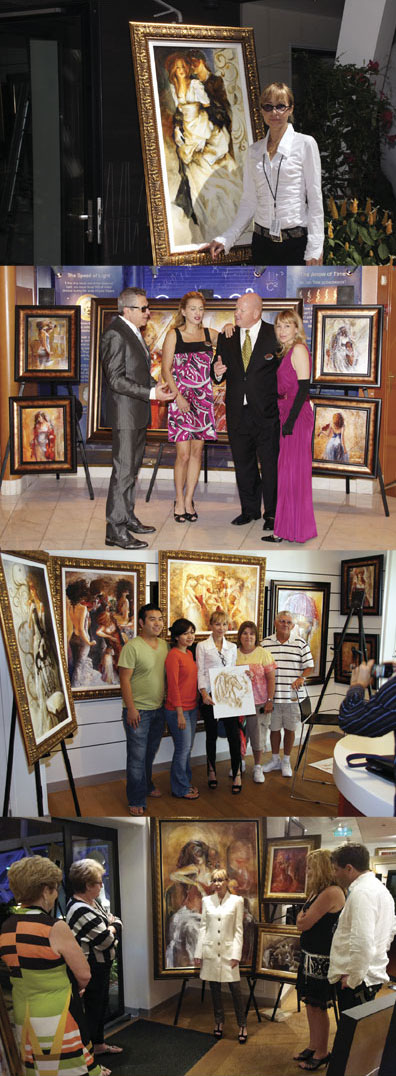 |
